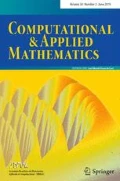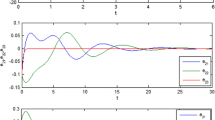Abstract
Many communication systems based on the synchronization of chaotic systems have been proposed as an alternative spread spectrum modulation that improves the level of privacy in data transmission. However, due to the lack of robustness of complete chaotic synchronization, even minor channel impairments are enough to hinder communication. In this paper, we propose a communication system that includes an adaptive equalizer and a switching scheme to alter between a chaos-based modulation and a conventional one, depending on the communication channel conditions. Simulation results show that the switching and equalization algorithms can successfully recover the transmitted sequence in different nonideal scenarios.








Similar content being viewed by others
Notes
In fact, \(\hat{x}_1(n)\) depends on \({\mathbf {w}}(n-1)\). However, considering this dependence, we need to use some other assumptions to derive the equalization algorithm. Furthermore, the resulting algorithm is more complicated and the achievable performance is similar to that of the algorithm derived here.
We use the term chaotic for the algorithms derived here only for distinguishing them from the original versions of LMS and normalized LMS (NLMS) algorithms (see, e.g., Sayed 2008). The use of this term does not imply a chaotic behavior of the algorithms. The subscript \(+\) is used here to distinguish this algorithm from that of Candido et al. (2014), which uses the product as encoding function and thus, denoted with the subscript \(\times \).
References
Abib GA, Eisencraft M, Batista AM (2013) Using coupled maps to improve synchronization performance. In: Eisencraft M, Attux R, Suyama R (eds) Chaotic signals in digital communications. CRC Press Inc, Boca Raton
Alligood KT, Sauer T, Yorke JA (1997) Chaos: an introduction to dynamical systems, textbooks in mathematical sciences. Springer, New York
Argyris A, Syvridis D, Larger L, Annovazzi-Lodi V, Colet P, Fischer I, Garcia-Ojalvo J, Mirasso CR, Pesquera L, Shore KA (2005) Chaos-based communications at high bit rates using commercial fibre-optic links. Nature 438(7066):343–346
Baptista MS, Macau EE, Grebogi C, Lai Y, Rosa E (2000) Integrated chaotic communication scheme. Phys Rev E 62:4835–4845
Candido R, Eisencraft M, Silva MTM (2013) Channel equalization for synchonization of Ikeda maps. In: Proc of 21st European signal processing conference (EUSIPCO’2013), Marrakesh, Marocco
Candido R, Eisencraft M, Silva MTM (2014) Channel equalization for synchronization of chaotic maps. Digit Signal Process 33:42–49
Candido R, Soriano DC, Silva MTM, Eisencraft M (2015) Do chaos-based communication systems really transmit chaotic signals? Signal Process 108:412–420
Cuomo KM, Oppenheim AV (1993) Chaotic signals and systems for communications. In: Proc IEEE int conf acoustics, speech, and signal process, Apr. 1993, vol 3, pp 137–140
Eisencraft M, Fanganiello RD, Baccalá LA (2009) Synchronization of discrete-time chaotic systems in bandlimited channels. Math Probl Eng 2009:1–12
Eisencraft M, Attux R, Suyama R Eds (2013) Chaotic signals in digital communications, CRC Press, Inc, Boca Raton
Haykin S (2001) Communication systems, 4th edn. Wiley, New York
Hénon M (1976) A two-dimensional mapping with a strange attractor. Commun Math Phys 50:69–77
Holland G, Vaidya N, Bahl P (2001) A rate-adaptive mac protocol for multi-hop wireless networks. In: Proceedings of the 7th annual international conference on mobile computing and networking, New York, NY, USA, MobiCom ’01, pp 236–251, ACM
Ikeda K (1979) Multiple-valued stationary state and its instability of the transmitted light by a ring cavity system. Opt Commun 30(2):257–261
Kennedy MP, Setti G, Rovatti R (eds) (2000) Chaotic electronics in telecommunications. CRC Press Inc, Boca Raton
Kolumban G, Kennedy MP, Chua LO (1998) The role of synchronization in digital communications using chaos. ii. Chaotic modulation and chaotic synchronization. IEEE Trans Circuits Syst I 45(11):1129–1140
Kolumbán G, Krébesz T, Tse CK, Lau FCM (2013) Basics of communications using chaos. In: Marcio E, Romis A, Ricardo S (eds) Chaotic signals in digital communications, chapter 4. CRC Press Inc, Boca Raton, pp 111–141
Pecora LM, Carroll TL (1990) Synchronization in chaotic systems. Phys Rev Lett 64(8):821–824
Pecora LM, Carroll TL, Johnson GA, Mar DJ, Heagy JF (1997) Fundamentals of synchronization in chaotic systems, concepts, and applications. Chaos: an interdisciplinary. J Nonlinear Sci 7(4):520–543
Picchi G, Prati G (1987) Blind equalization and carrier recovery using a “stop-and-go” decision-directed algorithm. IEEE Trans Commun COM 35:877–887
Sayed AH (2008) Adaptive filters. Wiley, NJ
Sethares WA (1992) Adaptive algorithms with nonlinear data and error functions. IEEE Trans Signal Process 40(9):2199–2206
Stavroulakis P (ed) (2005) Chaos applications in telecommunications. CRC Press Inc, Boca Raton
Williams C (2001) Chaotic communications over radio channels. IEEE Trans Circuits Syst I 48(12):1394–1404
Wu CW, Chua LO (1993) A simple way to synchronize chaotic systems with applications to secure communication systems. Int J Bifurc Chaos 3(6):1619–1627
Author information
Authors and Affiliations
Corresponding author
Additional information
Communicated by Jose Roberto Castilho Piqueira, Elbert E N Macau, Luiz de Siqueira Martins Filho.
This work was partly supported by CNPq under Grants 304275/2014-0, 479901/2013-9, and 309275/2016-4.
Rights and permissions
About this article
Cite this article
Candido, R., Silva, M.T.M. & Eisencraft, M. A new encoding and switching scheme for chaos-based communication. Comp. Appl. Math. 37 (Suppl 1), 253–266 (2018). https://doi.org/10.1007/s40314-017-0519-9
Received:
Revised:
Accepted:
Published:
Issue Date:
DOI: https://doi.org/10.1007/s40314-017-0519-9
Keywords
- Analysis and control of nonlinear dynamical systems with practical applications
- Chaos and global nonlinear dynamics
- Synchronization in nonlinear systems




